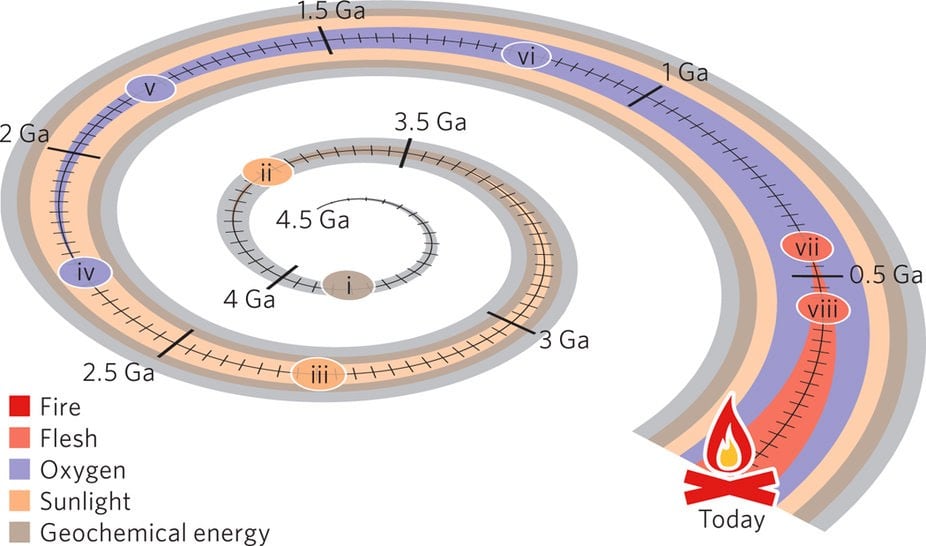The Earth’s five energy revolutions

Since life first formed on Earth billions of years ago, the ability of organisms to use more powerful and efficient energy sources has been key in driving the diversity and complexity of life. According to this provocative piece in Nature by Olivia Judson, the history of life on Earth can be divided into five energetic epochs characterized by the following energy sources: geochemical energy, sunlight, oxygen, flesh and fire.
The first two were present at the start, but oxygen, flesh and fire are all consequences of evolutionary events. Since no category of energy source has disappeared, this has, over time, resulted in an expanding realm of the sources of energy available to living organisms and a concomitant increase in the diversity and complexity of ecosystems. These energy expansions have also mediated the transformation of key aspects of the planetary environment, which have in turn mediated the future course of evolutionary change. Using energy as a lens thus illuminates patterns in the entwined histories of life and Earth, and may also provide a framework for considering the potential trajectories of life-planet systems elsewhere.
Organisms formed on Earth and changed the planet, which led to the formation of new organisms more suited to the new environment. For instance, when a type of bacteria evolved to turn sunshine into oxygen, it completely changed the planet.
In the absence of a biotic source of oxygen, trace quantities of the gas can be generated abiotically: water molecules can be split by sunlight or radioactive decay. However, these abiotic processes are much less efficient than their biotic equivalent. Had cyanobacteria, or something like them, never evolved, oxygen would never have built up in the atmosphere of the Earth.
But build up it did. Between 2.45 and 2.32 Ga, significant quantities of oxygen began to accumulate in the air, an episode known as the Great Oxidation Event. Before the Great Oxidation, atmospheric oxygen levels were less than 10^-5 of the present atmospheric level of ~21%. By ~2 Ga, they had risen to perhaps 0.1-1% of the present atmospheric level. Although the subsequent history of oxygen is complex and many details are uncertain, Earth’s atmosphere has contained an appreciable level of the gas ever since. (Full oxygenation of the oceans, however, would not happen until around 1.8 billion years after the Great Oxidation.)
The original piece in Nature is fairly readable for a science journal, but this summary in The Atlantic is worth a look if you’re short on time or attention. (via @CharlesCMann)





Stay Connected